
Cropsey Pond outlet stream
The big day has finally arrived; the 2014 Birdathon is finally here. Not a moment too soon either!
The excitement is palatable, waking me numerous times during the early morning hours before the sun makes even a faint appearance. Each time I do my best barred owl impression, trying to tempt one to respond. Greeting my calls are the disappointing but frequent peeps of a multitude of spring peepers, nearly deafening in their entirety. The resulting din probably makes it impossible to hear an owl unless it is right on top of me anyways.
Although still wet, it is no longer raining, which fills me with gratitude. The temperature is low enough to see my breath though, even inside my tarp shelter. The cold combines with an occasional drip from the surrounding trees compels my bladder into overdrive, making me exit the relative comfort of my sleeping bag and shelter to venture outside for an early morning pee. As I do my business, the beaver feels an obligation to slap its tail numerous times on the water, just to drive home its annoyance by my mere presence.
A glow off to the south signals the moon’s presence making for an eerie scene while taking an early morning respite. Just before reentering my tarp for a few more hours of sleep, I hear my first species for the day. Like many of the years past, the honor goes to an industrious (or just plain horny) white-throated sparrow down. On this year, the little guy is singing down along Cropsey Pond’s southern shoreline.
The sparrow sings but once before it probably does exactly what I do, go back to sleep.
Section Stats:
Date: May 17, 2014
Length: 0.6 miles (0.6 total daily miles; 2.5 total trip miles)
Difficulty: Easy
A little after four, with the darkness even more all-encompassing than before due to the disappearance of the moon, my sleep gets interrupted by a curious sound. After a few seconds, as the confusion of sleep subsides, the identity of the mysterious sounds becomes clear: a snorting white-tailed deer.
After a few initial snorts of derision, the deer falls silent, only to start again a few moments later but much closer than before. It is obviously curious about the weird structure I call a tarp, but after drawing in closer it must finally decide to get a drink elsewhere, as I never hear another snort or any other evidence of its presence again.
After another hour of slumber, the sun begins making its appearance to the east, with a cacophony of birds singing their approval. Hermit thrush, white-throated sparrow, ovenbird, common yellowthroat, Canada warbler, yellow-rumped warbler, and blackburnian warbler give me some early species for my beginning list – although if these common species were absent early then it might prove a very painful day of birding.
Even a barred owl adds its own contribution to the early morning chorus as it calls off into the distance, unbeknownst that its late arrival to the scene deprives it from being the first species on my list. After ceasing its calling several minutes later, it comes closer and begins anew. Maybe it did hear my pathetic calls from earlier this morning after all.
By about five-thirty in the morning, the temperature bottoms out around 39 degrees Fahrenheit in my shelter, just a tad bit warmer than frigid last year. The wet conditions combining with the low temperatures make today a perfect day for hypothermia. A fact not lost on me as I huddle down in my sleeping bag, content to do my birding almost entirely by ear until it gets a little bit warmer.
Make that a lot warmer, AND dryer.
Despite my ambitious agenda for the day, the cold and wet continue, leaving me little choice but to stay relatively warm and dry in my sleeping bag. From my vantage point underneath my tarp, I observe the precious heat-generating rays of the Sun reflecting off the billowy clouds, instead of reaching the chilly ground beneath.
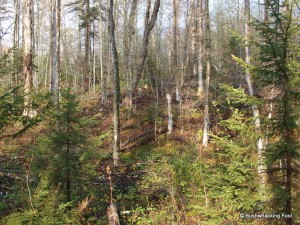
Blowdown hillside
An hour passes before I break the seal of my sleeping bag and venture out to explore the area for birdlife. A short jaunt down to the pond yields a pair of mallards flying overhead, with a pair of common goldeneyes (a north country diving duck) joining them after I startle them off the water. Or maybe the two beavers swimming around did the deed instead.
Slowly the sky clears, revealing the blue underneath. The earlier clouds, most likely just fog slowly burned away by the warming presence of the rising Sun, are not gone. Too bad those life-giving rays are not strong enough to raise the temperature more than a little; brrr, it is still cold out! Upon closer inspection, the sky still retains a few wispy clouds, slowly moving across the sky.
After collecting a few common bird species around my campsite, I take a short stroll over to the old inlet stream to the south. Cascading water flows from the blowdown-impacted hills to the south, the noise of the rushing water warning me of the intensity before ever seeing it, and consequently masking any bird song. Luckily, the birds are pretty active after the previous day’s inclement weather, allowing me to add several more common bird species to my burgeoning list.
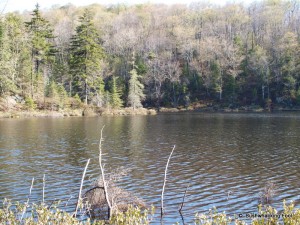
Cropsey Pond
Upon returning to my campsite, a quick breakfast of oatmeal and hot tea ensues, providing my fuel for a long day of birding. Following the meal, I set about dissembling my shelter and packing up my gear for the day’s hike. With daylight limited, I cannot delay any longer, especially if I want to make it past Sunshine Pond this year.
By 9:30 AM, my day’s bushwhack begins, initially heading west along the Cropsey shore toward the pond’s outlet stream. Finding the stream is not difficult, as its cascading water over the sturdy beaver dam makes it an obvious target. The dam keeps the ample water at bay, leaving numerous exposed rocks to act as a viable crossing downstream. The slick rocks combining with the loud tumult of water flowing around them makes for a crossing requiring the utmost care.
After a short bushwhack along the northern shore of the stream, the next pond along the outlet appears before me. The sound of water cascading over rocks surrounds me, as numerous small streams tumble down the steep hill to the north, eventually reaching the new beaver pond along the outlet stream. Where most years these small streams are mostly dry, even during mid-May, there is no sign of them letting up today.
Where a mudflat was present not too many years ago, the area is now completely underwater, the result of some industrious beavers and their well-constructed series of dams along the outlet stream. The steep slope to the north makes hiking along shore difficult, with the aforementioned small streams running downhill not making the going any easier.
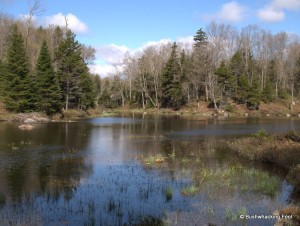
First beaver pond along outlet
The first dam after Cropsey Pond’s winds through the open area cutting the pond in two distinct parts. The stick and mud dam is quite impressive given its long length and extensive size. As I approach it, the water just seems to disappear behind the dam, falling several feet below to the rest of the stream. Beyond this serpentine dam stands another more traditional dam at the narrow end of the clearing, with many shrubs protruding from the water’s surface in between the two.
After passing the large, winding dam, I turn to look back for one last look at it before proceeding along to the next pond, already visible off in the distance before me. At this vantage point, the stick dam is even more impressive. It seems impossible that a small family of large rodents could build such a monstrosity, but alas, they did so. The rest of the dams along the outlet have a more traditional look, making this extensive dam all the more impressive.
It remains breezy as I slowly continue along the shoreline. More clouds moved in when I was busy looking for birds, which results in less sun and cooler temperatures. Despite the cooler temperatures, I remain warm and comfortable thanks to my EMS long johns and the Montbell down jacket. I refuse to lose them until the first hint of sweating. At this rate, it might just take a while.
Frigid temperatures provide one important benefit though: no bugs. The blackflies remain absent, most likely due to the lower temperatures, which is a damn good thing for mid-May. I would not trade warmer temperatures for their absence any day. Not that I have much choice on the matter.
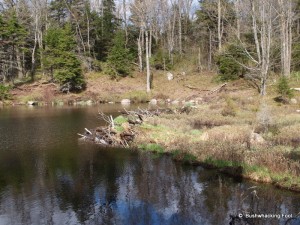
Winding dam along outlet
The steepness of the terrain combined with the dense brush around the next beaver dam, convinces me to retreat upslope and into the forest before continuing my trek along Cropsey Pond’s outlet stream. Once I climb to a point that makes my progress easier, I continue bushwhacking northwest away from the outlet until I find a convenient place to make a descent back to the stream’s edge.
The slope is steep, allowing me to watch the stream below through the trees. A blur of movement in the stream below catches my eye. At first, I am thinking beaver, but it appears too small and nimble for one of those dam-building rodents. When I get a better look at its tail, it becomes obvious that it is a muskrat instead.
Muskrats are a real treat to see in the Adirondack backcountry, as I rarely get to see one, especially from such a great vantage point. The beast continues to weave itself through the maze of rocks in the stream below, occasionally swimming for a short distance when a deeper pool presents the opportunity.
Realizing my luck, I stop and attempt to extricate my camera from its bag on my hipbelt. Unfortunately, the noise from the zipper, combined with my cursing, alerts the aquatic rodent of my presence. The little creature does a lightning fast one-eighty, hightailing it down the stream, alternating between scrambling over rocks and swimming effortlessly, using the current to accentuate its own skills. It takes only seconds before it has lost itself within the deeper water and surrounding vegetation just downstream.
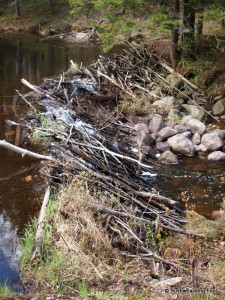
Beaver dam near Muskrat sighting
Although enjoyable, all good things must come to an end, so it is with the Cropsey outlet, at least my exploration of it. Beyond the final beaver pond, the stream enters the forest and fails to reemerge until it empties into Moshier Creek. This is where we part company, as I must bushwhack northwards toward the Deer Pond outlet stream. I shed a few layers of clothes before beginning my climb out of the Cropsey watershed and over the northern ridge and areas beyond.
At least the blackflies are not out and about yet. Too bad the bird species tend to be following their lead. Hopefully, my luck will change as I head north. Otherwise, it will be another disappointing Birdathon in the Pepperbox Wilderness.
Affiliate Disclaimer: Some links within this blog post may send you to a retailer’s website. If you chose to purchase any product on that site, this author may receive a small commission at no extra cost you. These commissions provide compensation for the author’s time and effort necessary to provide the content at the Bushwhacking Fool.




